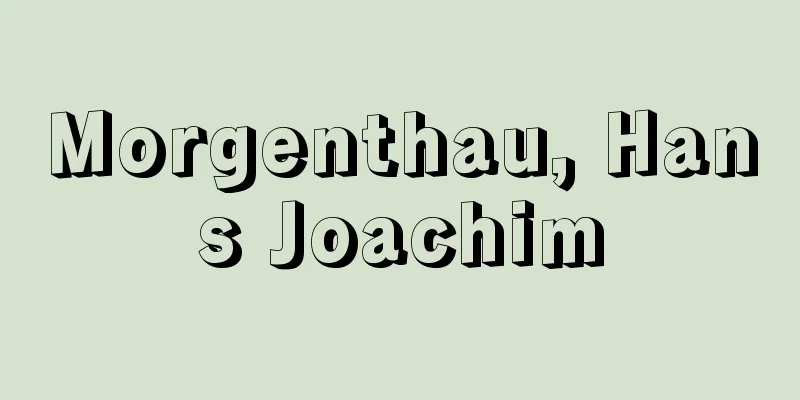Torii - Torii

|
They are also written as Torii, Torii, or Kabyou. They are built at the entrance to a shrine or at the boundary of a sacred area such as a mountain, river, or tomb. They are made of various materials such as wood, stone, copper, and concrete. When there are several Torii in the precincts, they are called by the number, starting from the one closest to the entrance: Ichi-no-torii, Ni-no-torii, etc. [Kudou Yoshiaki] kindsThe basic form of a torii gate consists of two pillars, a kasagi (head beam) on top of them, and a nuki (railed crosspiece) connecting the two pillars below the kasagi (head beam). Those with only a kasagi (head beam) on top of the pillar are collectively called Shinmei torii, while those with a square timber shimaki (striped beam) below the kasagi are collectively called Shimagi torii. The kasagi of the former is horizontal, while the kasagi and shimaki of the latter generally have curved ends and often have a gakuzuka (front beam) standing in the middle between the shimaki and the crossbeam. Shinmei torii can be further divided into the Kuroki torii of Saigū which uses cylindrical pillars covered with bark, the Yasukuni torii of Yasukuni Shrine which uses a round top rail and a square crossbeam, the Ise torii which has a pentagonal top rail with a ridge at the top, and the Kashima torii which has crossbeams that pass through the pillars, and sometimes only the Ise torii is called Shinmei torii. Shimagi torii can be broadly divided into Kasuga torii of Kasuga Taisha Shrine, which has horizontal kasagi and shimagi, and Myojin torii, which has curved kasagi and shimagi. Myojin torii are common torii and come in many varieties, but are further subdivided into daiwa torii, which has a circular lid-like base ring on the top of the pillar, Sanno torii of Hiyoshi Taisha Shrine, which has a fork on top of the kasagi, Hizen torii, which are found in the Fukuoka and Saga regions, with thick pillars at the base that taper towards the top and rounded ends of the kasagi and shimagi, and Ryobu torii, which has supporting pillars at the front and back of the daiwa torii pillars and connects them with crosspieces. Vermilion-painted daiwa torii are common at Inari Shrine, so they are also called Inari torii. Some of the larger Ryobu torii gates have a roof placed over the top of the lintel, and the Usa torii gate at Usa Shrine is a dairin torii gate with no lintel, but has a cypress bark roof placed over the lintel. Other unusual shapes include the Miwa Torii at Omiwa Shrine, which has three consecutive torii gates, and the Mihashira Torii at Oshimaza Amaterasu Mitama Shrine in Uzumasa, which has torii gates on three sides. Some shrines have slightly different shapes and torii gates with names unique to that shrine, so there are many types. The oldest surviving torii gates from the Heian period are the famous stone Myojin torii gates in Odachi and Zao Narisawa in Yamagata City, and an example of a gate with a clear date is the torii gate at Shitennoji Temple in Osaka City, dating from 1294 (Einin 2). [Kudou Yoshiaki] The origin of ToriiTorii is generally understood to be a perch for offering chickens to the gods, that is, a chicken gate, but there are various theories about the spelling and origin of the word, and there is no consensus. In the Wamyōshō and Irohajiruishō, it is written as “Kirisu” and explained as a place where birds live. It is also explained as meaning “passing in” or “stopping place”, but neither is confirmed. The Chinese kahyō is read as “torii” and is sometimes interpreted as the same as our torii, but torii and kahyō are not the same thing. The origin of the torii is divided into the imported theory and the indigenous theory, but at present it is not possible to determine which one it is. In terms of form, there are things similar to our torii in India (the torana that stands in front of a stupa), China (the pailō and the aforementioned kahyō), Korea (the red arrow gate), and so on, but it cannot be assumed that it was brought over as it is. In Japan, it is said that the torii gate originated when Amaterasu Omikami, who had secluded herself in a cave, set up a tree in front of the cave and had a rooster perch and crow. Another theory states that the torii gate originated from an unnamed pheasant perching on a tree in front of the gate of Amewakahiko, but neither of these theories have any basis. The torii gate mark is shown on maps as a symbol of shrines. The first shrine visit is called a torii pilgrimage, and a town that developed around a shrine is called a torii-maemachi, simply because the torii gate is a representative structure that indicates the shrine itself, but it is not clear what it corresponds to in a shrine. It is generally explained as a sacred gate, but even this is not convincing. [Ken Mitsuhashi] ©Katsuya Nishikawa "> Main types of torii gates A unique torii gate with a cross-shaped top and a kasagi (headboard). It is also called a "gassho torii gate." Otsu City, Shiga Prefecture © Lake Biwa Visitors Bureau, Public Interest Incorporated Association "> Sanno Torii of Hiyoshi Taisha Shrine Source: Shogakukan Encyclopedia Nipponica About Encyclopedia Nipponica Information | Legend |
|
鳥井、鶏居、華表とも書く。神社の入口や山、川、陵墓などの聖域の境目に建つ。木造、石造、銅製、コンクリート造などいろいろな材料がある。境内に数基の鳥居が建つ場合は、入口に近いほうから一の鳥居、二の鳥居と数字を冠してよぶ。 [工藤圭章] 種類鳥居の基本形式は2本の柱と、その上にのる笠木(かさぎ)、笠木の下方で2本の柱をつなぐ貫(ぬき)からなる。 柱頂に笠木だけのものを神明(しんめい)鳥居と総称し、笠木下に角材の島木(しまき)のあるものを島木鳥居と総称する。前者の笠木は水平だが、後者の笠木・島木は一般に両端が反り上がり、島木と貫の間の中央に額束(がくづか)が立つものが多い。 神明鳥居を細分すると、樹皮のつく円柱を用いた斎宮(さいくう)の黒木(くろき)鳥居、円い笠木と角形の貫を用いた靖国(やすくに)神社の靖国鳥居、上部に鎬(しのぎ)をつけて五角形の笠木ののる伊勢(いせ)鳥居、貫が柱を貫通する鹿島(かしま)鳥居などがあり、とくに伊勢鳥居だけを神明鳥居とよぶことがある。 島木鳥居を大別すると、笠木・島木が水平になる春日(かすが)大社の春日鳥居と、笠木・島木の反り上がる明神(みょうじん)鳥居に分かれる。明神鳥居は一般的な鳥居で種類が多く、さらに柱頂に円形の蓋(ふた)状の台輪(だいわ)がのる台輪鳥居、笠木の上に叉首(さす)を組む日吉(ひえ)大社の山王(さんのう)鳥居、福岡や佐賀地方にみられる柱の根元が太く、上にゆくにしたがって細まり、笠木・島木の端が円まっている肥前鳥居、台輪鳥居の柱の前後に控柱(ひかえばしら)を立てて貫でつなぐ両部(りょうぶ)鳥居などに細分される。台輪鳥居のうち朱塗りのものは稲荷(いなり)神社に多いので、稲荷鳥居ともいう。両部鳥居の大規模なものは笠木上面に屋根をかけるものがあり、また、宇佐(うさ)神宮の宇佐鳥居は額束のない台輪鳥居の形式だが、笠木上に檜皮葺(ひわだぶ)きの屋根をかけている。 このほか、鳥居が三つ連続する大神(おおみわ)神社の三輪(みわ)鳥居や、三面に鳥居が巡る太秦(うずまさ)の大嶋座天照御魂(おおしまにますあまてらすみたま)神社の三柱(みはしら)鳥居など珍しい形のものがある。神社によってはやや形を変えてその神社独特の名称をつけた鳥居もあって、種類が多い。 現存最古の平安時代の鳥居としては、山形市小立(おだち)や同市蔵王成沢(ざおうなりさわ)の石造明神鳥居が有名であり、年代の明らかなものには1294年(永仁2)の四天王寺(大阪市)の鳥居がある。 [工藤圭章] 鳥居の起源一般に鳥居は、神に鶏を供えるときの止まり木、すなわち鶏居であると解されているが、表記や語源については諸説があって一定していない。『和名抄(わみょうしょう)』『伊呂波(いろは)字類抄』などには「鶏栖」と表記し、鳥の居る所と説明してある。また「通り入り」「止処(トマリヰ)」の意などとも説明されるが、いずれも確証はない。中国の華表(かひょう)を「トリイ」と訓(よ)み、わが国の鳥居と同意に解することもあるが、鳥居と華表は同じものではない。鳥居の起源は外来説と在来説とに分けられるが、現在のところどちらかに確定することはできない。形式からすれば、わが国の鳥居に似たものはインド(ストゥーパの前に立つトラーナ)、中国(牌楼(ぱいろう)や前出の華表)、韓国(紅箭(こうせん)門)などにもあるが、それがそのままもたらされたと考えることもできない。 わが国では天照大神(あまてらすおおみかみ)が岩屋に籠(こも)られたとき、岩戸の前に木を立て鶏を止まらせて鳴かせたのが鳥居の始まりであるといい、一説に天稚彦(あめわかひこ)の門前の湯津杜木(ゆつかつら)に無名雉(ななしきじ)が止まり居ることを鳥居の起源とするなどの説もみられるが、いずれも根拠のあることではない。鳥居のマークは神社のシンボルとして地図などに示されている。初宮詣(もう)でのことを鳥居参りといい、神社を中心にして発達した町を鳥居前町(とりいまえまち)と称するなどは、鳥居が神社そのものを示す代表的な建造物であるからにほかならないが、それが神社の何にあたるかは明確ではない。一般には神門であると説明されるが、これとて納得のできるものではない。 [三橋 健] ©西川勝也"> 鳥居のおもな種類 笠木の上に叉首を組む独特の形状の鳥居。「合掌鳥居」ともよばれる。滋賀県大津市©公益社団法人びわこビジターズビューロー"> 日吉大社の山王鳥居 出典 小学館 日本大百科全書(ニッポニカ)日本大百科全書(ニッポニカ)について 情報 | 凡例 |
>>: Durian - Dorian (English spelling) durian
Recommend
Fundamental matrix
...Therefore, if we use Φ( t ) to represent the m...
Leisewitz, JA (English spelling)
...The major playwrights of this movement can be ...
Warner, H.
…American film company. The four Warner brothers,...
Hacılar (English spelling)
…Kaki [Masashi Hamashima] [Western] People have l...
Seki City
Gifu City is located in the central-southern part ...
nidifugous
…In the latter case, the eggs are smaller, making...
purging nut
…It is also called Taiwan tallow. Its English nam...
Tree Pangolin - Tree Climbing Pangolin
... They live in a variety of environments, from ...
Neuberin
…German actress and touring theater leader. Commo...
Takeda Izumo
A writer and promoter of Joruri Gidayu-bushi. Fir...
Michiyanagi - Michiyanagi
An annual plant of the Polygonaceae family (APG c...
spermocarp
…After fertilization, a cellular filament extends...
Seared
(1) A type of shamisen playing technique. The plec...
Yellow-horned dragonfly - Yellow-horned dragonfly
An insect belonging to the family Polypteridae in...
Martin, W. (English spelling) Martin W
… The promotion of Westernization began with the ...


![Manazuru [town] - Manazuru](/upload/images/67cce91f3366d.webp)






